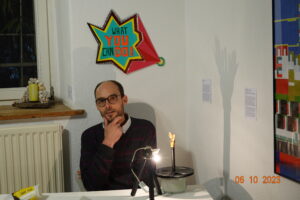Light on your feet
10 years of GG3, 10 years of sustainable art – Light on its feet sees itself as a distillation of efforts to create sustainable art, to foreground the theme of sustainability through the means of art. In this context, sustainable art is defined as works for which as few resources as possible have been used, i.e. which have a very small “ecological footprint”. But it is not infinitely small, it would be only if the art were no more than a thought (if any), and we could not look at it together in the gallery. So an exhibition always leaves a footprint. Here’s an attempt: To compensate for this, one could make the “handprint” of art, i.e. what art can achieve in terms of a sustainable future, as large as possible. Of course, the dimensions of the art object are of least importance, but rather the symbolic shadow it casts. The size and effect of the shadow depend on the position, strength and diffusion of the light source shining on the artwork, and on the projection surface you offer the shadow. Thus, the symbolic shadow of art can become infinite. In addition, there are proven ways to increase it by applying more hands to the hand of the artwork – this could be art criticism, for example, or Instagram. However, this shadow cannot grab anything, and therefore cannot move anything directly. It is symbolic. What the great hand of art then does: It can point to something or someone.
Illuminating shadows
So let’s look at the symbolic shadow of some of the works that are in this exhibition to check what they refer to. First – obvious – Christiane Gaeberts BERLINBERLINconsisting of plans of the pre-turnaround city, cut up and reshaped into delicate sculptures whose shadows make me think of a butterfly, a plant or the like. Berlin, the motoring city, appears like an organic being against a gray background. A glimpse of a promising future? Or Andrea Gollas Waste Your Time – She has created a beguiling carpet from waste, the chemical composition of which is probably very similar to that of a department store carpet. What do we buy in the furniture store other than tomorrow’s trash. So we probably have to come to a different way of dealing with all these things than always trying to get rid of what we have just acquired as quickly as possible. Mariel Gottwicks A new world every week again comes very close to talking about the work of art as a thought. The visitors are asked to rebuild the world – in the form of boxes with allusive inscriptions – from which ever new word games arise. Invisible question marks always appear behind the words, so the reconstruction of the world never comes to a harmonious end. The hand mentioned above meets us in its largest possible version as Stephan Great’ Hand of God, whose counterpart is a vase modeled after a coral – product of evolution or creation, depending on your worldview. The divine spark passes over to the design object. Or maybe the inspiration goes the opposite way, if Ludwig Feuerbach was right and man has indeed created God in his image. (The hand in this work is, after all, only made of porcelain, from which the title cleverly distracts). This small work therefore casts a huge shadow, as already indicated.
Artfully off the mark
The shadow of our own past falls upon us in the form of Claudia Michaela Kochsmeier’s
Shapes steeped in history evoke a sense of reality
. Emotions are triggered by the TV she presents us with, because in it the earlier TV-mediated fears and annoyance are suspended as nostalgia. What we couldn’t sleep because of in the past, we are comfortably munching on today. How else to explain the infotainment flood of historical documentaries and old news broadcasts on the Internet portals of TV stations (https://www.ardmediathek.de/retro). Kochsmeier covered the television with a layer of sand in which she left a footprint. This layer reminds us that not only most of the earlier fears, but also the promises of the time have been blown away by what actually happened. It is almost certain that the same will soon be said about today’s visions of the future.
We inevitably succumb to new errors (and sometimes old ones anew). So what we have to strive for is not to be right in the end. Our goal should be that our errors are not as fatal as the falls of
Christoph Medicus’ throwing doll
from
Don’t you throw yourself away again
?.
The doll throws itself into the abyss for us. Perhaps in this way art helps us to circumnavigate one or the other fatality by always being one error, one doom ahead of us. Because artists are allowed or supposed to do just that: go astray. But please on such a high level as in this exhibition.

